THE WAR DEPARTMEN1 ND THE SIX-WHEELER.
Page 62
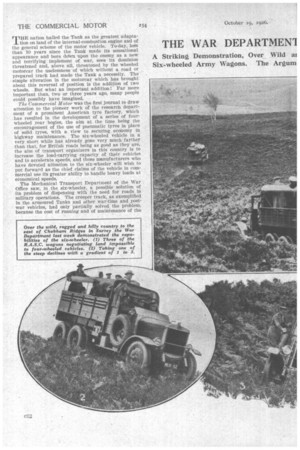
Page 63
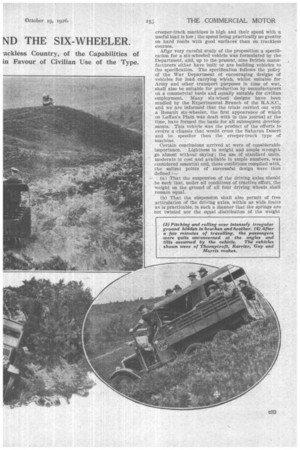
Page 64
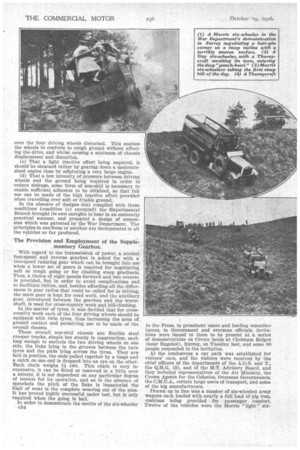
Page 65
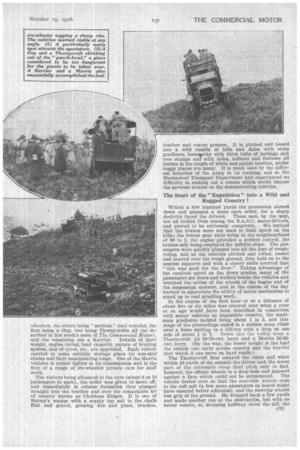
Page 66
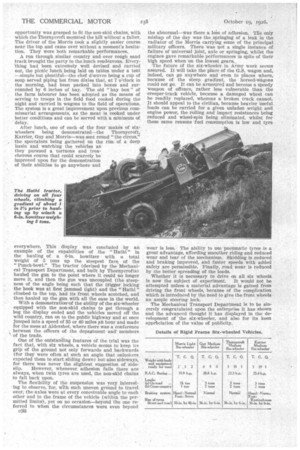
If you've noticed an error in this article please click here to report it so we can fix it.
THE nation hailed the Tank as the greatest adaptation on land of the internal-combustion engine and of the general scheme of the motor vehicle. To-day, less
than 10 years since the Tank made its sensational appearance and bore do'wn upon the enemy as a new and terrifying implement of war, sees its dominion threatened and, above all, threatened by the wheeled motorcar the uselessness of which without a road or prepared track had made the Tank a necessity. The simple alteration in the motorcar which has brought about this reversal of position is the addition of two wheels. But what an important addition!' Far more important than, two or three years ago, many people could possibly have imagined.
The Commercial Motor was the first journal to draw attention to the pioneer work a the research department of a prominent American tyre factory, which has resulted in the development of a series of fourwheeled rear bogies, the aim at the time being the encouragement of the use of pneumatic tyres in place of solid tyres, with a view to securing economy in highway maintenance. The six-wheeled vehiele in a very short while has already gone very much farther than that, for British roads being as good as they are, the aim of transport organizers in this country is to increase the load-carrying• capacity of their vehicles and to accelerate speeds, and those manufacturers who have devoted attention to the six-wheeler will wish to put forward as the chief claims of the vehicle in commercial use its greater ability to handle heavy loads at economical speeds.
The Mechanical Transport Department of the War Office saw, in the six-wheeler, a possible solution of its problem of dispensing with the need for roads in military operations. The creeper track, as exemplified in the armoured Tanks and other war-time and postwar vehicles, had only partially solved the problem, because the cost of running and of maintenance of the creeper-track machines is high and their speed with .a useful load is low ; the Speed being practically no greater on hard roads with good surfaces than on trackless courses.
After very careful study of the proposition a specification for a six-wheeled vehicle was formulated by the Department, and, up to the present, nine British manufacturers either have built or are building vehicles to the specification. The specification follows the policy of the War Department of encouraging designs of vehicles for load carrying which, whilst suitable for Army and other transport purposes in time of war, shall also be suitable for production by manufacturers on a commercial basis and equally suitable for civilian employment. Many six-wheel designs have been studied by the Experimental Branch of the R.A.S.C., and we are informed that the trials carried out with a Renault six-wheeler, the first appearance of which on LFiffan's Plain was dealt with in this journal at the time, have formed the basis for all subsequent developments. This vehicle was the product of the efforts to evolve a chassis that would cross the Saharan Desert and be speedier than the creeper-track type of machine.
Certain conclusions arrived at were of considerable importance. LightnesS in weight and ample strength go almost without Saying; the use of standard units, moderate in cost and available in ample numbers, was considered essential and, these conditions complied with, the salient points of successful design were thus defined : (a) That the suspension of the driving axles should be such that, under all conditions of tractive effort, the weight on the ground r5f all four driving wheels shall remain equal.
(b) That the suspension shall also permit of free articulation of the driving axles, within as wide limits as is practicable, in Such a manner that the springs are not twisted nor the equal distribution of the weight over the four driving wheels disturbed. This enables the wheels to conform to rough ground without affecting the drive, and whilst causing a minimum of chassis displacement and distortion.
(c) That a light tractive effort being required, it should be obtained rather by gearing clown a moderatesized engine than by ediploying a very large engine.
(d) That a low intensity of pressure between driving wheels and the ground being required in order to reduce sinkage, some form of non-skid is necessary to enable sufficient adhesion to be obtained, so that full use can be made of the high tractive effort provided when travelling over soft or friable ground.
In the absence of designs that complied with these conditions (condition (c) excepted) the Experimental Branch brought its own energies to bear in an eminently practical manner, and prepared a design of suspension which was patented by the War Department. The principles in onelorm or another are incorporated in all the vehicles so far produced.
The Provision and Employment of the Supple mentary Gearbox."
With regard to the transmission of power, a nortnal four-speed and reverse gearbox is asked for with a two-speed reducing gear which can be brought into use when a lower set of gears is required for negotiating soft or rough going or for climbing steep gradients. Thus, a choice of eight speeds forward and two reverse Is provided, but in order to avoid complications and to facilitate tuition, and, besides affording all the differences in gear ratios that could be called for in driving, the main gear is kept for road work, and the auxiliary gear, introduced between the gearbox and the wormshaft, is used for cross-country work and hill-climbing. in the matter of tyres, it was decided that for crosscountry work each of the four driving wheels should be equipped with twin tyres, thus increasing the area of ground contact and permitting use to be made of the overall chassis.
These overall non-skid chassis are flexible steel creeper tracks, simple but sturdy in construction, each long enough to encircle the two driving wheels on one side, the links lying in the grooves between the twin tyres and the pads lying across the tyres. They are laid in position, the ends pulled together by a tongs and a catch on one end is dropped into an eye on the other. Each chain weighs 1 cwt. This chain is very inexpensive, it can be fitted or removed in a little over a minute, it is not dependent on any particular degree of tension for its operation, and as in the absence of sprockets the pitch of the /inks is immaterial the limit of wear is the complete wearing out of the pins. It has proved highly successful under test, but is only required when the going is bad.
In order to demonstrate the merits of the six-wheeler c34 to the Press, to prominent users and leading manufacturers, to Government and overseas officials, invitations were issued to them to be present at a series of demonstrations on Crown lands at Chobham Ridges (near Bagshot), Surrey, on Tuesday last, and some 80 people responded to the invitation.
At the rendezvous a car park was established for visitors' cars, and the visitors were received by the chief officers of the departments of the A.D.S. and T., the Q.M.G. (3), and of the M.T. Advisory Board, and they included representatives of the Air Ministry, the Crown Agents for the Colonies, Overseas Governments, the C.M.U.A., certain large users of transport, and some of the big manufacturers.
Drawn up in line was a number of six-wheeled army wagons each loaded with nearly a full load of pig iron, cushions being provided• for passenger comfort. Twelve of the vehicles were the Morris " light " six
wheelers, the others being " medium" load vehicles, the first being a Guy, two being Thornycrofts A3 (as described in last week's issue of Thz Commercial Motor), and the remaining one a Karrier. Details of their weight, engine rating, load capacity, nature of braking system, size of tyres, etc., are appended. Each vehicle carried in some suitable storage place its non-skid chains and their manipulating tongs. One of the Morris vehicles is rather lighter in its transmission and is the first of a range of six-wheeled private cars for staff work.
The visitors being allocated to the cars (about 8 or 10 passengers to each), the order was given to move off, and immediately In column formation they plunged straight into the heather and over the remarkable bit of country known as Chobham Ridges. It is one of Surrey's wastes with a scanty top soil to the chalk flint and gravel, growing firs and pines, bracken, heather and coarse grasses. It is pitched and tossed into a wild tumble of hills and dales with steep gradients, huninapcky with thick tufts of herbage and tree stumps and with holes, hollows and furrows all hidden in the tangle of white and purple heather, whilst boggy places are many. It is much used by the different branches of the Army in its training, and so the Mechanical Transport Department had experienced no difficulty in staking out a course which would impose the severest strains on the demonstrating vehicles.
The Start of the "Expedition" into a Wild and Rugged Country !
Within a few hundred yards the procession slowed down and assumed a more open order, for a sharp declivity faced the drivers. These men, by the way, are all picked from among the R.A.S.C. motor-drivers, and proved to be extremely competent. We noticed that the brakes were not used to limit speed on the hills; the lowest gear ratio being in the neighbourhood of 90 to 1, the engine provided a perfect control, the
brakes only being employed for definite stops. The passengers were quickly plunged into all the joys of rough
riding, and as the vehicles pitched and rolled, tossed and heaved over the rough ground, they held on to the nearest supports and with a cheery smile averred that "this was good for the liver." Taking advantage of the cautious speed on the down grades, many of the passengers got down and walked beside the vehicles and watched the action of the wheels of the bogies and of the suspensign systems, and in the course of the day learned to appreciate the ability of motor mechanism to stand up to real gruelling work.
In the course of the first hour or so a distance of about five or six miles was covered over what a year or so ago would Aave been described in connection with motor vehicles as impossible country, the maximum gradients tackled being about 1 in 3, and this stage of the proceedings ended in a sudden steep climb over a loose surface to a hill-top with a drop on one side of About 1 irk L'. Down into the valley went a Thornycroft A3 30-50-cwt, lorry and a Morris 203Ocwt. lorry. (By the way, the lesser weight is the load the vehicle can carry across country and the heavier that which it can move on hard roads.) The Thornycroft first essayed the climb and when within 10 yards of the summit the driver took the worst part of the extremely steep final pitch only to find. however, the offside wheels in a deep hole and jammed against a face which could not be surmounted. The vehicle heeled over so that the near-side wheels spun in the soft soil (a few more passengers on board might have ensured better adhesion), and the steering wheels lost grip of the ground. He dropped back a few yards and made another run at the obstruction, but with no better results, so, dropping halfway down the hill, the
opportunity was grasped to fit the non-skid chains, with which the Thornycroft mounted the hill without a falter. The driver of the Morris took a slightly easier course near the top and came over without a moment's hesitation. They were both remarkable performances.
A run through similar country and over rough sand track brought the party to the lunch rendezvous. Every"thing had been extremely well devised and carried out, the picnic lunch being laid on tables under a tent --simple but plentiful—the chef d'ceuvre being a cup of soup served piping hot from dixies that, at 7 o'clock in the morning, had been packed into boxes and surrounded by flinches of hay. The old " hay box" of the farm labourer has been adopted as the means of serving to troops in the field food cooked during the night and carried in wagons to the field of operations. The system is a great improvement upon previous commissariat arrangements, as the meat is cooked under better conditions and can be'served with a minimum of delay. After lunch, one of each of the four makes of sixwheelers being demonstrated—the Thornycroft, Karrier, Guy and Morris—was sent round "the circus," the spectators being gathered on the rim of a deep basin and watching the vehicles as they pursued a tortuous and treacherous course that could scarcely be improved upon for the demonstration of their abilities to go anywhere and everywhere. This display was concluded by an example of the capabilities of the " Hathi " in the hauling of a 6-in, howitzer with a total weight of 5 tons up the steepest face, of the "Punch-bowl." The tractor (devised by the Mechanical Transport Department, and built by Thornyerofts) hauled the gun to the point where it could no longer move it, and then the gun was uncoupled (the steepness of the angle being such that the trigger locking the hook was at first jammed tight) and the " Hathi " climbed to the top, had its front wheels scotched, and then hauled up the gun with all the ease in the world.
With a demonstration-of the ability of the six-wheeler equipped with the non-skid chains to get through a bog the display ended and the vehicles moved off the wild country, ran on to the public highway and at once jumped into a speed of 35 or 40 miles ati hour and made for the mess at Aldershot, where there was a conference between the officers of the department andmembers of the trade.
One of the outstanding features of the trial was the fact that, with six wheels, a vehicle seems to keep its grip of the ground not only forwards and backwards (for they were often at such an angle that onlookers expected them to start sliding down) but also sideways, for there was never the slightest suggestion of side slip. However, whenever adhesion fails there are always, when twin tyres are used, the non-skid chains to fall back upon.
The flexibility of the suspension was very interesting to observe, 'for, with such uneven ground to travel over, thsraxles were at every conceivable angle to each other and to the frame of the vehicle (within the permitted limits), yet on no occasion—beyond the one referred to when the circumstances were even beyond c36 the abnormal—was there a Ios of adhesion. Tile only mishap of the day was the springing of a leak in the radiator of the Morris carrying some of the principal military officers. There was not a single instance of failure of universal joint, axle or springing, whilst the engines gave remarkable performances in spite of their high speed when on the lowest gears. The future of the six-wheeler in Army work seems assured. It will take the place of the G.S. wagon and, indeed, can go anywhere and even to places where, because of the steep gradient, the horsed-wagons could not go. It can be armoured and become a speedy weapon of offence, rather less vulnerable than the creeper-track vehicle, because a damaged wheel can be readily replaced, whereas a broken track cannot. It should appeal to the civilian, because heavier useful loads can be carried for a given unladen weight and engine power, the rolling and impact resistances being reduced and wheel-spin being eliminated, whilst for these same reasons fuel consumption is low and tyre wear is less. The ability to uSe pneumatic tyres is a great advantage, affording smoother riding and reduced wear and tear of the mechanism. Skidding is reduced and braking improved, and faster speeds with added safety are permissible. Finally, road wear is reduced by the better spreading of the loads.
Whether it is necessary to drive on all six wheels is now the subject of experiment. It would not be attempted unless a material advantage is gained from driving the front wheels, because of the complication which is introduced by the, need to give the front wheels an ample steering lock.
The Mechanical Transport Department is to be sincerely congratulated upon the enterprise it has shown and the advanced thought it has displayed in the development of the six-wheeler, and also for its keen apprkiation ci the value of publicity.




























































































































